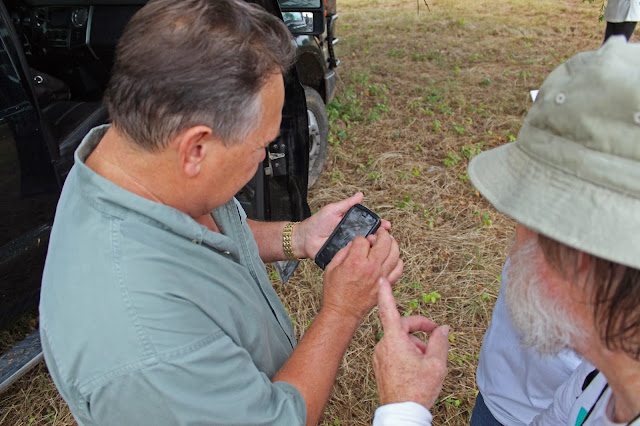Running Wild With Urban Feral Hogs In Dallas — The Trinity River Forest Trails
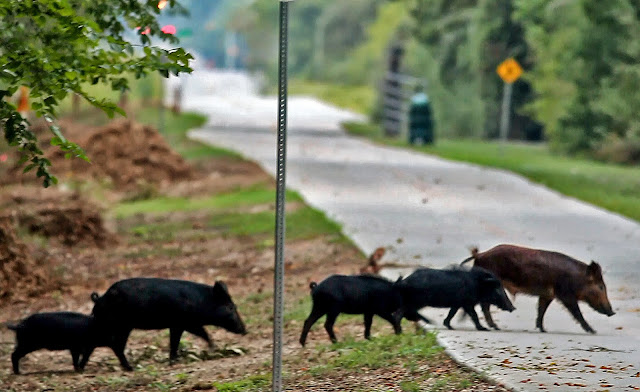 |
| A dozen feral pigs crossing a hike and bike trail in Dallas, Texas Trinity River Trail October 2013 |
The vast expanse of territory inside the boundaries of Texas contains some of the most diverse environments found anywhere in the world. From the picturesque canyons of the North to the fertile alluvial areas along the South coast, the country vastly changes in every form of geology, ecology and habitat known to man. The constant in all of this, from the rugged mountains of Big Bend to the far sandy beaches of the Sabine are an ever expanding menace to the state, the wily feral pig.
 Once the plague of rural farmers and ranchers, feral pigs have started a slow but continual march into suburban and even urban areas in the state. Dallas is one such city, with the Trinity River serving as a natural wildlife corridor which neatly bisects the metropolis. The river greenspace serves as a wildlife highway, allowing near unrestricted access for pigs to meander freely from one zip code to the next along the floodplain.
Once the plague of rural farmers and ranchers, feral pigs have started a slow but continual march into suburban and even urban areas in the state. Dallas is one such city, with the Trinity River serving as a natural wildlife corridor which neatly bisects the metropolis. The river greenspace serves as a wildlife highway, allowing near unrestricted access for pigs to meander freely from one zip code to the next along the floodplain.
Were it not for the destruction that feral pigs cause here in Texas, the sight of a dozen feral pigs crossing Dallas newest concrete bike path would be quite amusing. For those not familiar with feral hogs it would be a chance to laugh and joke about the critters as they mosey through the woods unaware of nearby humans.
The reality is that the damage they can unleash is monsterous. Not just costly to repair in terms of dollars, the unseen damage is that to the native plants and animals that call the Trinity River home. A single pig family can damage the Trinity River Forest in ways that can take decades for nature to repair.
It’s rather unfortunate that pop culture has sensationalized feral pigs into some super-strong zombie beast that will kill your pets and burn your house down. It’s not that way at all. It has become commonplace that most visits to the Trinity River that I will have hog encounters. Not a big deal for me, nor should it be a big deal for anyone reading this. They are an unnatural invasive species of the woods not man-eating monsters. If one were claiming to having been attacked by pigs or having ones pants shredded or feeling the need to carry a pistol in your waistband for protection, well, you’d be labeled a fool. You’d be a laughing stock. A legend in your own mind.
Feral Pigs (Sus scrofa)
Feral pigs, also known as wild hogs, wild boar or feral swine are an Old World species and are not native to the Americas. The first wild pigs in the United States originated solely from domestic stock brought to North America by early European explorers and settlers. Many years later, Eurasian wild boar were introduced into parts of the United States for hunting purposes. In areas where domestic pigs and Eurasian wild boar were found together in the wild, interbreeding occurred. Today, many hybrid populations exist throughout the wild pig’s range.
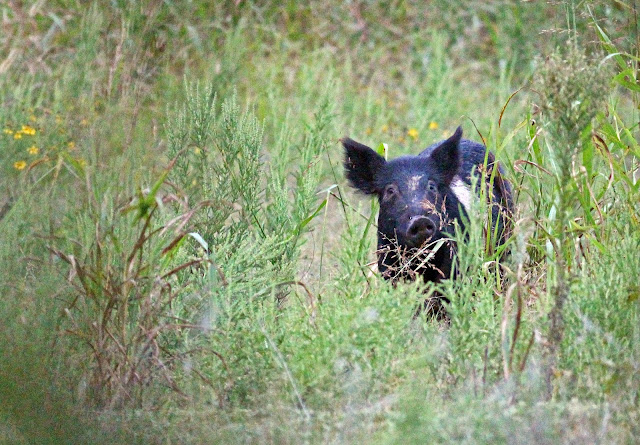 |
| A feral pig casually dining on a breakfast of plant roots in the Great Trinity Forest |
 |
| Double stuffed colored oreo pig in Dallas October 2013 |
In Dallas especially, the feral pigs show the true inbreeding of former domesticated pig genetics and the “wild boar” species hunted on exotic game ranches. Dallas sees many “oreo” colored feral pigs the traditional trademark of a Hampshire domestic breed. Many generations previous to the current pigs, I would guess that domestic Hampshires were turned loose or escaped, then bred with Eurasian wild boar stock to give the rough color markings.
Feral Pig Hotspots According To The City of Dallas
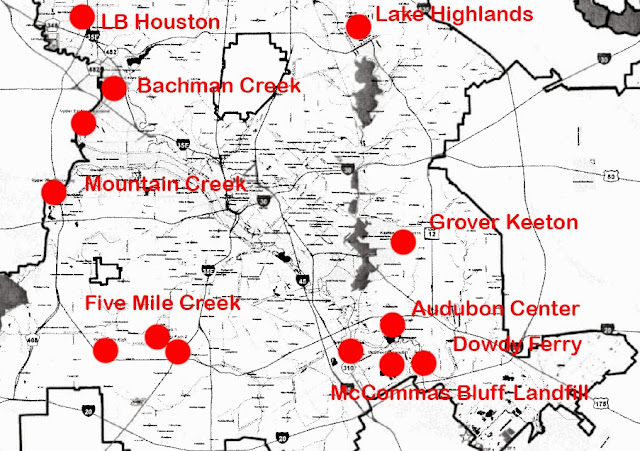 |
| Feral Pig Hotspots noted in the City of Dallas RFP for the 2013 Feral Hog Abatement Program |
Feral pigs cannot fly. Nor can they navigate unscathed across the vast network of freeways and interlocking interstates inside the city limits of Dallas. How they move so freely around town is a secret of the animal world. The map above is from the 2013 Feral Hog Abatement RFP Packet. I have highlighted the hot spots noted in the packet. At a glance, the problem appears to be city wide and patterned to look like a wholesale invasion of immense size. Nothing could be further from the truth. The random dots are not random at all and make more sense if one overlays the wildlife corridors that exist in Dallas.
 |
| Major wildlife corridors for land base animals in Dallas, Texas |
Wildlife corridors run from rural parts of Dallas County straight into the heart of Downtown. The width of the Trinity River Floodway coupled with a lack of development in the flood plain allows animals like deer, coyotes and pigs to travel up and down the Trinity River and tributaries with great ease. Few fences exist other than the Wastewater Treatment Plant. No matter, the animals can easily ford the river to go around the fences. Smaller wildlife corridors like Prairie Creek, Elam Creek, Turtle Creek and Bachman Creek can be used as avenues for travel too.
Lake Highlands– The outlier for the data is Lake Highlands and the random pig or two seen there. Some idiot is releasing pigs there. Someone who does not understand the topography of White Rock Lake, the Spillway fencing or inability of a feral pig to traverse the Arboretum, Forest Hills Neighborhood and Flag Pole Hill before safely making it to the confines of White Rock Creek north of Northwest Highway. Not possible. Pigs can go amazing places across all that area unnoticed and without hitting all the bottle necked corks in the terrain is simply not possible for a pig.
The Lake Highlands feral pigs are solitary and juveniles of small size. Pigs like that never leave their family unit called a “sounder”. I have discussed this with a few wildlife biologists and they all think independently that someone is catching pigs elsewhere and releasing one or two at a time north of Northwest Highway and south of Walnut Hill. They need to be caught and thrown in jail.
White Rock Lake Feral Hog
Who dumped this pig? Not my video below:
http://www.youtube.com/watch?v=sH9CIDxeyhs
This juvenile feral pig is scared out of it’s head near Mockingbird and Buckner, March 2013. It was killed by a vehicle impact at the corner of Northcliff and Buckner shortly after. Until recently I had only seen a cell phone photo of the feral pig, dead, photo taken by a Dallas Police Officer who showed it to me some days later. This was a feral pig that some human turned loose. Why they would do such a thing is unknown.
Dallas Trinity River Pig Problem
The real concern is what unchecked damage feral pigs are inflicting on the more fragile areas of what the city calls “The Great Trinity Forest”. This 6,000-10,000 acre chunk of land(depending who you ask) has some real gems of native wildlife and rare plant species. Pigs love eating all of it which can cause some real trouble.
Feral pigs are “opportunistic omnivores,” meaning they’ll eat most anything. Using their extra-long snouts, flattened and strengthened on the end by a plate of cartilage, they can root as deep as three feet. They’ll devour or destroy whole field of sorghum, rice, wheat, soybeans, melons and other fruits, nuts, grass and hay.
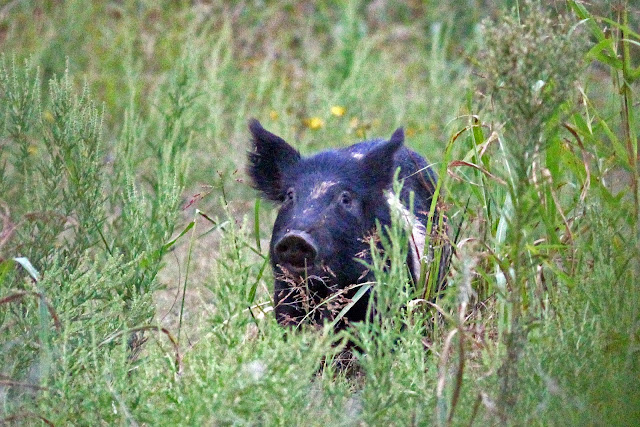 |
| A feral pig eating the seeds of Johnson Grass at Joppa Preserve |
Calvert Collins of KDFW Fox 4 reports on the Trinity River pig problem in August:
In the Great Trinity Forest very little acreage is under cultivation to any extent but natural food plots and habitat destruction are a real issue. They compete with the native wildlife, including the white-tailed deer, squirrels, and waterfowl, for food and territory. Hogs may also change plant community composition favoring exotics through disturbance and seed dispersal. They may also affect soil structure, soil nutrients, input of nutrients to streams, and stream invertebrates via their rooting, defecation, and urination. Hogs are very selective in their choice of foraging areas and will often pattern their rooting in certain spots.
 |
| High reeds acting as a shoreline screen for a photographer shooting birds at Joppa Preserve |
The ongoing damage at Little Lemmon Lake, Joppa Preserve in the Fall of 2013 is a prime example of feral pig rooting damage. As seen below, the pigs have moved into the southeast corner of the lake and uprooted a large area of reeds and aquatic plants. The pigs are most likely after freshwater mussels, crawfish and grubs in addition to the tubers and roots that grow in this environment.
 |
| 50×50 foot square area of damage to the lakeshore of Little Lemmon Lake October 2013 |
The reeds here serve as a breeding ground for tree frogs in the summers and provide a buffered screen for smaller animals to live. It will take years for the reeds to grow back from what was probably only an evening or two of rooting by feral pigs.
Algae blooms, oxygen depletion, bank erosion and soured water have all been attributed to the wallowing behavior of feral hogs, reducing the availability of water sources for livestock and wildlife.
Wallowing in either mud or dust is a common activity among mammals, birds and reptiles, but wallowing in mud is especially notable among pigs and piglike animals, as well as among large mega-herbivores with relatively hairless skin, such as elephants, rhino’s, hippo’s, water buffalos and warthogs.
| Hog wallow at Little Lemmon Lake October 2013 |
The damage caused by feral swine is further magnified if the definition of damage is broadened to include the potential for transmission of diseases to domestic livestock. Feral swine can harbor a number of diseases transmissible to livestock and/or humans. The pork industry in the United States has nearly eradicated swine brucellosis and pseudorabies, but feral swine serve as a potential reservoir from which these diseases can be transmitted back to domestic stock.
The very real threat of feral hogs transmitting disease has prompted the future city owned Texas Horse Park to install a remote activated cell phone feral hog trap. Watch more about it here Wireless trapping technology at the Texas Horse Park
As demonstrated above, President of River Ranch Charities Wayne Kirk shows archeologist Tim Dalbey a smartphone app that controls the trap at the nearby Horse Park. The photo shows a 2am alert to an animal in the open stockade. In this case, the animal was a stray black lab dog and the trap door was not activated.
If You Encounter Feral Hogs
Feral pigs are as smart or smarter than many dog breeds. They have better noses and sense of smell than any dog and an adult can run 30mph for brief periods. They also have lackluster eyesight and poor hearing. Coupled with a complete focus on foraging for food 6 inches from their nose, they might not hear or see a human if approached from downwind.
Feral pigs are not much more than renegade livestock. The largest pigs are male boars and are solitary. As long as you give them some room and let them know you are present, they will leave the area. They are non-confrontational and will always get out of your sight very quickly.
 |
| Pig Sounder at Joppa Preserve |
Female pigs known as sows and their babies run in family groups called sounders. Since a female sow can have two litters per calendar year, the sounder is usually multi-generational with a mother, maybe some of her siblings, newborn babies and then some from pigs from the previous litter which one could consider tween or teenaged feral pigs.
If you encounter a large family sounder, just be quiet, still and observe from a distance. As long as the sounder stays together they are not a danger to humans. Really, you could walk right up to them and nothing would happen other than a brief scattering of pigs.
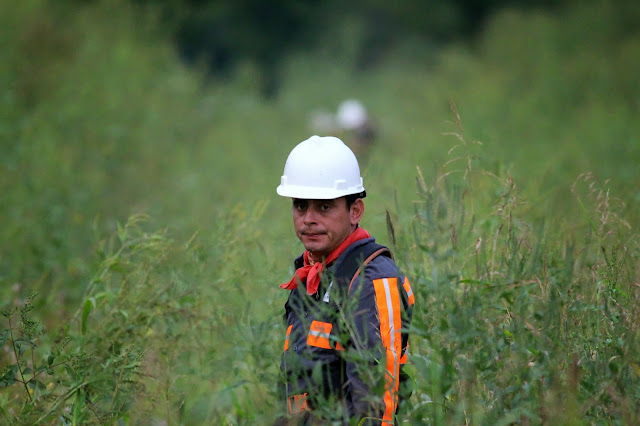 |
| Atmos pipeline crew on the Trinity River Trail October 2013 |
Always good conversation talking with others down on on the Trinity. Guys like work crews are a great source of information about area wildlife, animal encounters and eager to share odd happenings. No problems with pigs from these guys. Or mountain lions, chupacabras or bears for that matter.
Generally nocturnal on the Trinity River, pigs are most often seen in the hours around dawn or dusk. Be aware of your surroundings, enjoy yourself and you will never have a problem.
A Reminder: Hunting Is Illegal On City of Dallas Land, Dallas County Nature Preserves and Parks
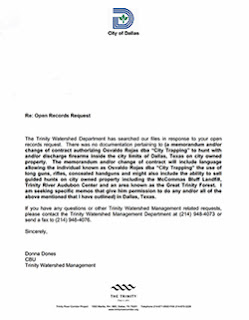 |
As far as I can tell, through phone calls, exhaustive open records requests and conversations with the Dallas Police Department, no one is allowed to hunt on City of Dallas property. No one. Beaten this
issue into one that has become a dead horse with the poaching here. The NO HUNTING issue applies to even lowly feral pigs which are not even game animals in the State of Texas. Unlawful discharge of a firearm and/or hunting with airguns, bows, spears, arrows, knives on the Trinity River in parks and public lands is strictly forbidden. Game Wardens are now very aware of the situation at hand here and are ready to enforce the law if needed.
If you want to hunt pigs, great! There are plenty of farms and ranches just down the river, many are only a 10-20 minute drive south of I-20 that will gladly let you hunt pigs, birds and even deer. The classified section of the Dallas Morning News and Craigslist have numerous hunting leases available if so inclined. http://www.dallasnews.com/classifieds/ and Craigslist Hunting Leases
Want to shoot guns on the river, great! Head over to the Elm Fork where a legal gun range will let you punch holes in paper, static targets and even clay pigeons for cheap. Their website http://www.elmfork.com/. Cheaper than a trip to jail, which is what shooting guns down in the Great Trinity Forest will get you.

